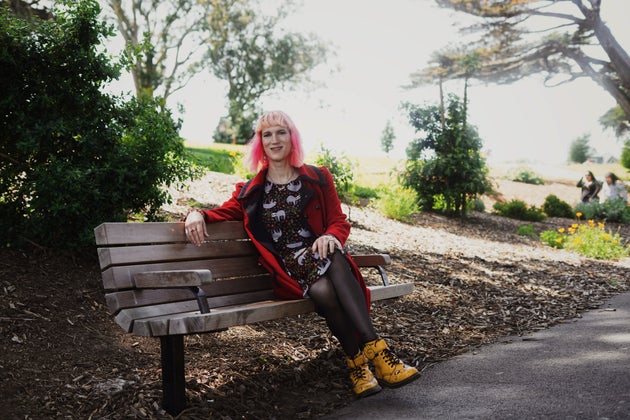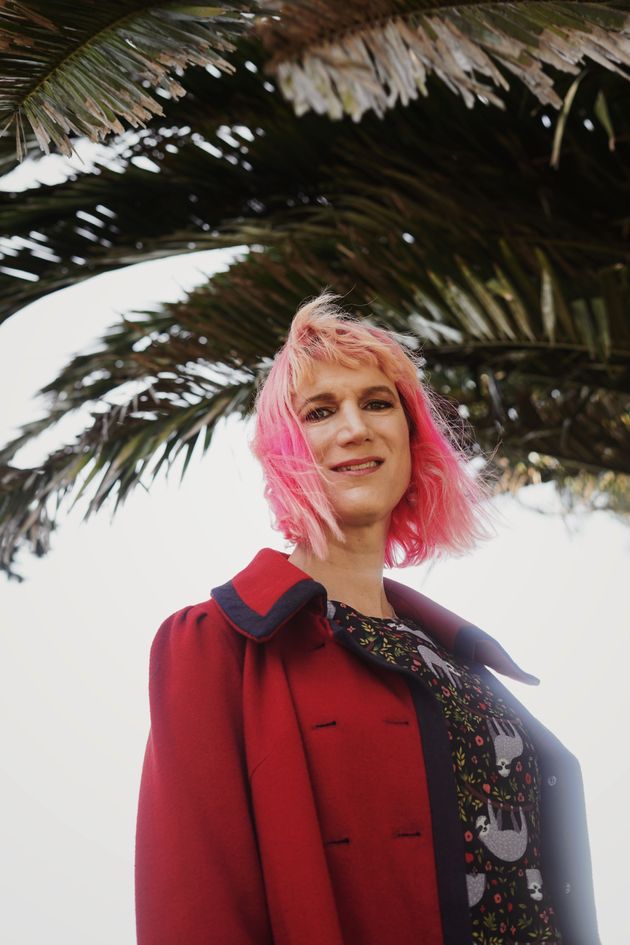
Photos by Texas Isaiah
“I think that what we’re going to see,” science fiction author Charlie Jane Anders tells me, “is conflict over access to water.” We’re deep into a phone interview, and the topic of climate change has come up. As anyone who has read her work would expect, she’s bursting with predictions gleaned from her research. Apart from water access issues, she also expects an increase in violent storms and food scarcity in the future.
“I can walk down the street and get a million different kinds of cuisines, and in the supermarket there’s an incredible selection of fruits and vegetables,” she says. “I think that may not always be the case.”
In her work, Anders has looked further still into the future: Her new novel, “The City in the Middle of the Night,” is set on another planet threatened by climate change, centuries after humans relocated from a presumably dying Earth. It’s a rather bleak image ― not the shiny techno-utopian futurism that promised us flying hoverboards.
“There’s this discussion that always goes on in speculative fiction about whether you write optimistic or pessimistic stories,” she says, “or whether we can have the optimism of the old days of ‘Star Trek’ — this idea that we’re going to build a better future. And have we lost that? Can we get that back?”
“I always say that optimism and pessimism about the future really boiled down to optimism and pessimism about human nature. Are we going to destroy ourselves? Or are we going to be able to work together and fix some of the problems that we’ve caused?”
Anders describes herself as a realist: “It’s a little of column A, and it’s a little of column B.” It’s not a brave new world, or even a “Brave New World,” but something messy in between.
Anders’ work is a study in duality, as she explores unfamiliar extremes while also figuring out how the distance between them can be traversed. Her breakout sci-fi/fantasy novel “All the Birds in the Sky″ features a star-crossed couple who meet as misfit kids. One grows up to be a witch and the other becomes a tech geek, which puts them on different sides of a calamitous battle for the future of the planet. “It’s kind of magic versus science, or nature versus technology,” Anders says.
Her latest, “The City in the Middle of the Night,” takes place on a tidally locked planet ― in other words, a planet that keeps the same face toward its sun throughout its orbit. It’s a concept that Anders discovered while working for the science and tech blog io9.
“Scientists were saying that if humans do manage to colonise another planet outside of our solar system, it is likely to be tidally locked,” she says. That’s because planets that have favourable atmospheres and liquid water frequently are. Centuries into the future, conceivably, humans could live on a planet where day and night are not functions of time’s passage.
“This idea of people being caught between two actual extremes of day and night, and the burning hot sunlight and the freezing darkness, it really took hold of me,” she says. It raised endless questions: What kinds of beings might live on the dark side of such a planet? Could humans communicate with them? And, of course, when do people sleep and how do they measure the passage of time when you live in uninterrupted dusk?
Anders constructed a world with two distant cities — separated by a dangerous, barren wasteland — that took exactly opposite approaches to the problem of timelessness, and populated it with characters troubled by their inability to belong in the place where they’ve found themselves. One character, Mouth, is the sole surviving member of a nomadic group that was totally wiped out when she was just a little girl. She continues to wander, restless and in search of an identity. Another character, Sophie, a shy lower-class girl who becomes a fugitive after protecting her wealthy friend from a police investigation, finds acceptance from a species native to the planet.
Anders’ characters often start out alienated and then find themselves by traveling away from their unwelcoming home to a place where they can embrace their true selves. For Patricia, the witch heroine of “All the Birds in the Sky,” that place is a magic school far from her hostile older sister and schoolmates. For Sophie in “The City in the Middle of the Night,” that place is the titular city, home of the native creatures known as “crocodiles” by humans and who have become Sophie’s friends.
And for Anders, that place is San Francisco. Born and raised in a small farm town near Storrs, Connecticut, she found it “a little bit too quiet” for her taste. A child, she read voraciously and wrote stories (including, she noted, plenty of “Dr. Who” fan fiction). As the result of a learning disability, she worked with a special education teacher who further encouraged her artistic impulses.
“If I was able to master the basic schoolwork, I would get to write a little stage play,” she says. She attended Cambridge University and lived abroad in Asia before eventually deciding, around the turn of the millennium, to move to the Bay Area.
“I was starting to think about transitioning. I was starting to think about coming out as queer in general,” she says. “I wanted to live in a place where there was more support for that, where there was a whole queer community.”
She was drawn to the city’s vibrant cultural scene as well. Once she arrived, she threw herself into San Francisco’s thriving world of queer art and culture: spoken word nights, open mics, festivals, performances, magazines. For several years, she worked for the magazine Anything That Moves, a publication aimed at bisexual people that “took its mission as a bisexual magazine very broadly, and had a very diverse staff, and a lot of attention to issues that were orthogonal to the bisexual struggle,” Anders says. She published in other small magazines and volunteered to help with events and Folsom Street Fair booths ― “just hanging out on the fringe of this amazing scene,” she put it.
At the time, she was writing intensely about her own identity, from personal essays to her debut novel, “Choir Boy,” which she describes as “my weird transgressive trans novel.” And she was surrounded by other writers, many of whom were grappling with similar ideas. The literary scene offered fertile artistic ground. She remembers “writing more honestly about sexuality and gender and my own … evolving identity as a queer person,” but also learning about the mechanics of storytelling through writing erotica. (“You have to establish character really quickly, and you have to set up the conflict of the story really quickly, in an erotica story,” she says.)
After a while, she moved on. Many of the magazines she worked with were folding or pivoting. She was burned out from writing about her identity so much and worried that, as a white trans person, she was taking up space that should be ceded to trans people of colour. In 2008, journalist Annalee Newitz started io9 as Gawker Media’s sci-fi blog, and Anders joined as an editor. She had a new focus. “I was just becoming an authority on sci-fi,” she says.
Since then, Anders has blossomed into a well-established sci-fi author and moved toward more oblique representations of transness in her fiction, creating trans and nonbinary characters in her genre writing without delving explicitly into questions of transition or identity discovery.
“I like having characters who … their transness is not the point of the story, but that their transness is hinted at,” she says. One character’s transition is never mentioned, save for an offhand reference to his chest scars itching.
“Basically, if you’re a member of a particular group, you’re supposed to write about your experiences in this one really circumscribed way,” she says. “Often, in a way that people from the mainstream, dominant group can understand, and it’s the way that they’re used to.”
“We’re still just scratching the surface,” she says of trans literature.

Sci-fi may lend itself particularly well to exploring trans themes. Often, the people who are the best at looking into the future are those who have already learned what humans can deny each other, what damage they can inflict by withholding understanding and acceptance.
“The feeling of alienation and of difference is something that is threaded throughout speculative fiction,” Anders says. “My experiences as a trans person always come back in my writing,” particularly “the desperate struggle to claim your identity … an identity that people either don’t understand or are hostile to.”
After Donald Trump’s presidential election win, however, Anders found herself considering whether visibility should take more precedence in her writing. “I really had a fire lit under me again,” she said, “and a feeling that I have to do what I can with whatever platform I have to help trans people be more visible and to help people to see the humanity of trans people.”
In January 2017, as the nation prepared for Trump’s inauguration, she wrote a searing speculative story, “Don’t Press Charges and I Won’t Sue,” about a trans woman undergoing a brutal form of medical conversion therapy. “It was very explicitly … my kind of response, as a trans person, to the Trump era.”
Anders says she’s not well-suited for activism ― “I learned the hard way back in the day,” she says ― but has found that she’s more adept at expressing her concerns in fiction. Even her least overtly political fiction circles around vital social questions, such as how vastly different people can build bridges of understanding and how humans can find ways to survive rather than spiralling into mutual destruction.
“I’m really interested in people learning to understand each other and in people having more empathy for each other,” she said. “I think that part of what we’ve seen going on in the world around us is people not really being able to communicate, not being able to understand each other.” Particularly, she noted, people need to remain open “to marginalised people who have often really painful stuff to share.”
And if we want to survive the future ahead of us, she says, everyone needs to recommit themselves to that kind of empathy. “We’re going to have to do some hard thinking,” she says. “Rethinking how we behave as humans, and possibly being a little bit less selfish.”
The interview is part of HuffPost’s Proud Out Loud project, which profiles the next generation of LGBTQ change-makers from around the world to mark 50 years since the Stonewall Riots.